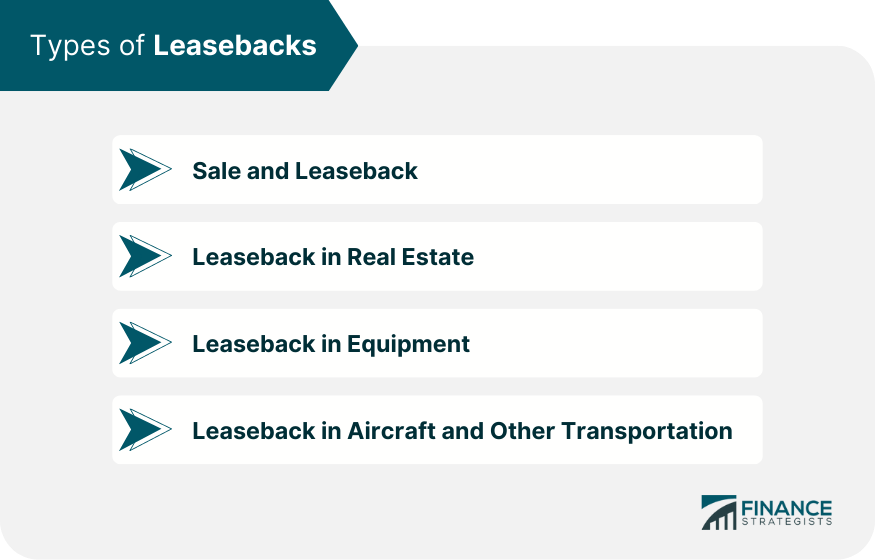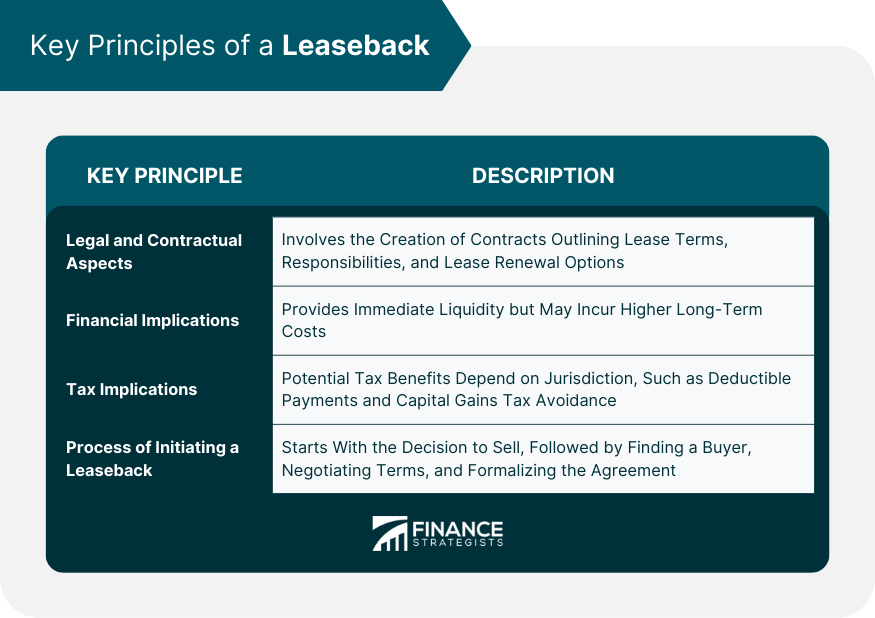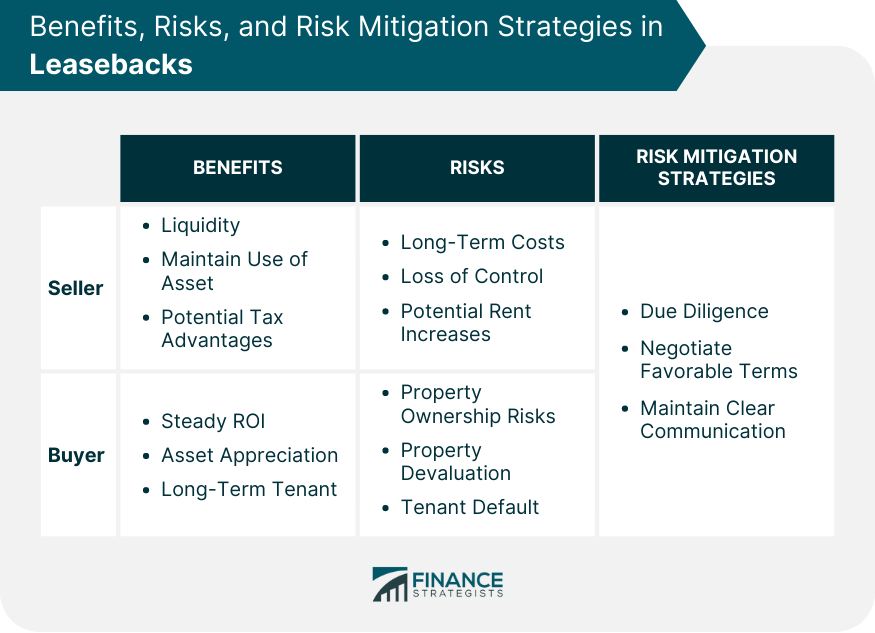Leaseback, also known as sale-and-leaseback, is a financial arrangement where a company sells an asset and then leases it back from the purchaser. This strategy frees up capital tied in assets for the seller while offering a secure investment for the buyer. For businesses, this might help improve liquidity, manage debts, and enable continued use of the asset. Understanding leaseback can enhance your financial literacy, potentially aiding in personal investment or business decisions. Leaseback is prevalent in real estate, aircraft, and equipment financing. However, it’s important to consider factors such as the terms of the leaseback agreement, potential tax implications, and the condition of the asset. Ultimately, leaseback offers a nuanced approach to asset management and capital allocation, highlighting the interconnectedness of ownership and use in our modern economy. Sale and Leaseback is the most common type of leaseback transaction. It occurs when a company sells a property or an asset to a buyer and then leases it back. The lease agreement usually sets out the terms, including the lease period, rent payments, and responsibilities of the seller and buyer. In a real estate leaseback, a company sells its buildings or land and then rents them back. This form of leaseback is popular among businesses with significant investments in real estates, such as retail stores and restaurants. Equipment leaseback involves a company selling machinery or other equipment and leasing it back. This form is prevalent in industries that use expensive machinery, like manufacturing or construction. Leaseback in aircraft and other forms of transportation involves airlines or shipping companies selling their aircraft or ships and then leasing them back. This method allows companies to maintain their operations without the financial burden of owning the assets. Legal and contractual aspects play a significant role in a leaseback transaction. Parties involved must draw up contracts outlining the terms of the lease, including rental rates, lease terms, maintenance responsibilities, and lease renewal options. Financially, a leaseback can offer immediate liquidity to a business. However, over the long term, the company may end up paying more in lease payments than if it had retained ownership. In certain jurisdictions, leaseback transactions can offer significant tax benefits. Depending on the tax laws, the payments may be deductible, and the sale might help avoid capital gains tax. The process begins with the owner deciding to sell an asset and lease it back. Following this decision, the owner must find a willing buyer, negotiate the terms, and finally, formalize the agreement in a contract. Liquidity: Through a leaseback agreement, the seller (also the lessee in this arrangement) can free up cash that was previously tied up in assets. This liquid capital can then be used for a variety of purposes such as expansion. Maintain the Use of the Asset: Even after selling the asset, the seller can continue using it by entering into a lease agreement with the new owner. This ensures that their business operations aren't disrupted. Potential Tax Advantages: Lease payments are often considered business expenses and can be deducted from the taxable income, potentially reducing the seller's tax liability. Steady Return on Investment: With the seller becoming the lessee, the buyer (lessor) is guaranteed a steady flow of rental income, which can serve as a stable return on their investment. Asset Appreciation: If the asset appreciates in value over time, the buyer could sell it at a profit in the future. Long-Term Tenant: Given that the former owner is likely to be committed to staying on as a tenant, the buyer gains a long-term, reliable tenant. Immediate Access to Capital: If a company is in need of cash for any reason, selling an asset and leasing it back can provide immediate liquidity. Offloading Asset Management Responsibilities: When the company sells the asset, the responsibility of maintaining and managing it falls to the new owner, allowing the original owner to focus more on their core business operations. Tax Benefits: As mentioned, the lease payments could be tax-deductible, providing financial benefit to the seller. Long-Term Costs: Although leasebacks can provide immediate capital, over the long term, the seller (now lessee) could end up paying more in rent than the asset's original value. Loss of Control: Since the seller no longer owns the asset, they lose some control over it. They cannot make changes to the asset without the owner's (lessor's) permission. Potential Rent Increases: The new owner could increase the rent at the end of the lease term, adding to the lessee's costs. Property Ownership Risks: As the new owner, the buyer takes on all risks associated with property ownership, such as maintenance costs and potential damage to the property. Property Devaluation: If the value of the asset decreases, the owner might face financial losses if they decide to sell. Tenant Default: The new owner also assumes the risk of the lessee defaulting on their lease payments. Due Diligence: Thoroughly evaluating the asset and its value, as well as the financial stability of the seller/lessee, can help mitigate risks. Favorable Terms: Negotiating a lease agreement that offers beneficial terms, such as a reasonable rent and clear provisions regarding maintenance, can protect both parties. Clear Communication: Maintaining open lines of communication throughout the lease term can help address any potential issues promptly and fairly. In the US, leaseback transactions are governed by both federal and state laws, with specifics depending on the type of asset involved. In the EU, laws around leaseback can vary between member states, though they generally adhere to certain common principles set out in EU regulations. In Asia, leaseback laws differ widely across countries, with some countries offering significant incentives to encourage such transactions. Different regulatory environments can significantly impact the attractiveness and feasibility of leaseback transactions. Therefore, understanding these differences is crucial when considering a leaseback in a foreign jurisdiction. Technology, particularly blockchain and smart contracts, could streamline leaseback transactions by automating contractual obligations and providing greater transparency. Global economic and financial changes, such as shifts in interest rates, inflation, and economic downturns, can affect the appeal and viability of leaseback transactions. In the coming decade, leasebacks may become increasingly popular as businesses seek alternative financing options. There may also be greater diversification in the types of assets involved in leaseback arrangements. Leaseback, a nuanced financial strategy involving the sale of an asset and subsequent leaseback, holds multifaceted implications for businesses and investors alike. While spanning real estate, equipment, and transportation, each transaction necessitates careful consideration of lease terms, financial and tax implications, along with associated risks. Offering potential benefits, including liquidity and continuous asset usage for sellers and a steady return on investment for buyers, leasebacks can serve as strategic financial tools. However, understanding the varied laws and regulations in different jurisdictions is crucial. As technology evolves, it promises to reshape leaseback transactions, making them more efficient and transparent. With global financial changes potentially impacting the appeal of leasebacks, it's anticipated that this strategy may gain popularity and diversify further in the future. Leveraging leasebacks requires sound knowledge, due diligence, and astute decision-making, highlighting its role as a significant player in modern finance.What Is a Leaseback?
Types of Leasebacks
Sale and Leaseback
Leaseback in Real Estate
Leaseback in Equipment
Leaseback in Aircraft and Other Transportation

Key Principles and Mechanisms of Leasebacks
Legal and Contractual Aspects
Financial Implications
Tax Implications
Process of Initiating a Leaseback

Benefits of Leasebacks
Benefits for the Seller
Benefits for the Buyer
Other Circumstances When a Leaseback Is Advantageous
Risks and Challenges in Leasebacks
Risks for the Seller
Risks for the Buyer
Mitigation of Risks

Leaseback in Different Jurisdictions
Leaseback Laws and Regulations in the United States
Leaseback Laws and Regulations in the European Union
Leaseback Laws and Regulations in Asia
Comparison and Analysis of Different Regulatory Environments
Future Trends in Leasebacks
Impact of Technology on Leasebacks
Impact of Changes in Global Finance and Economy on Leasebacks
Predicted Trends for Leasebacks in the Next Decade
Final Thoughts
Leaseback FAQs
A leaseback, also known as a sale-and-leaseback, is a financial arrangement in which a company sells an asset, often real estate, to a buyer and then immediately leases it back from the buyer. This transaction allows the company to continue using the asset while no longer owning it.
The main types of leaseback arrangements include sale and leaseback, leaseback in real estate, leaseback in equipment, and leaseback in aircraft and other transportation. The type is determined by the kind of asset involved in the transaction.
Leaseback can provide immediate liquidity to a company, maintain its use of an asset, and possibly offer tax benefits. For the buyer, it can provide a long-term tenant and a steady return on investment.
The seller in a leaseback arrangement may pay more in the long term, lose control over the asset, and face potential rent increases. The buyer takes on the risks of property ownership, including potential property devaluation and the risk of the seller defaulting on lease payments.
Leaseback laws and regulations can vary significantly across different jurisdictions, such as the United States, the European Union, and Asia. The local regulatory environment can impact the attractiveness and feasibility of leaseback transactions, hence the need for due diligence when considering a leaseback in a foreign jurisdiction.
True Tamplin is a published author, public speaker, CEO of UpDigital, and founder of Finance Strategists.
True is a Certified Educator in Personal Finance (CEPF®), author of The Handy Financial Ratios Guide, a member of the Society for Advancing Business Editing and Writing, contributes to his financial education site, Finance Strategists, and has spoken to various financial communities such as the CFA Institute, as well as university students like his Alma mater, Biola University, where he received a bachelor of science in business and data analytics.
To learn more about True, visit his personal website or view his author profiles on Amazon, Nasdaq and Forbes.











